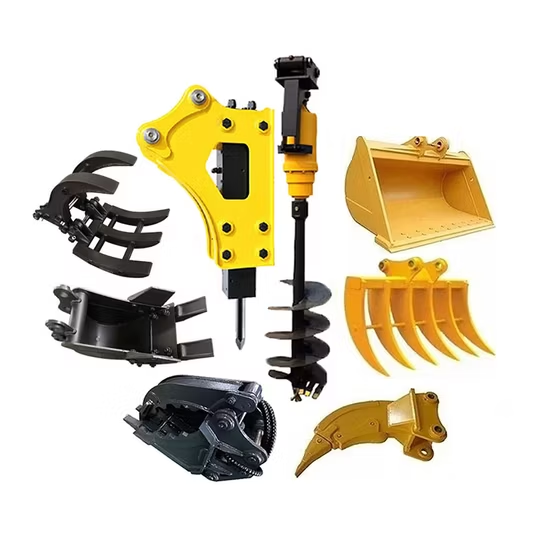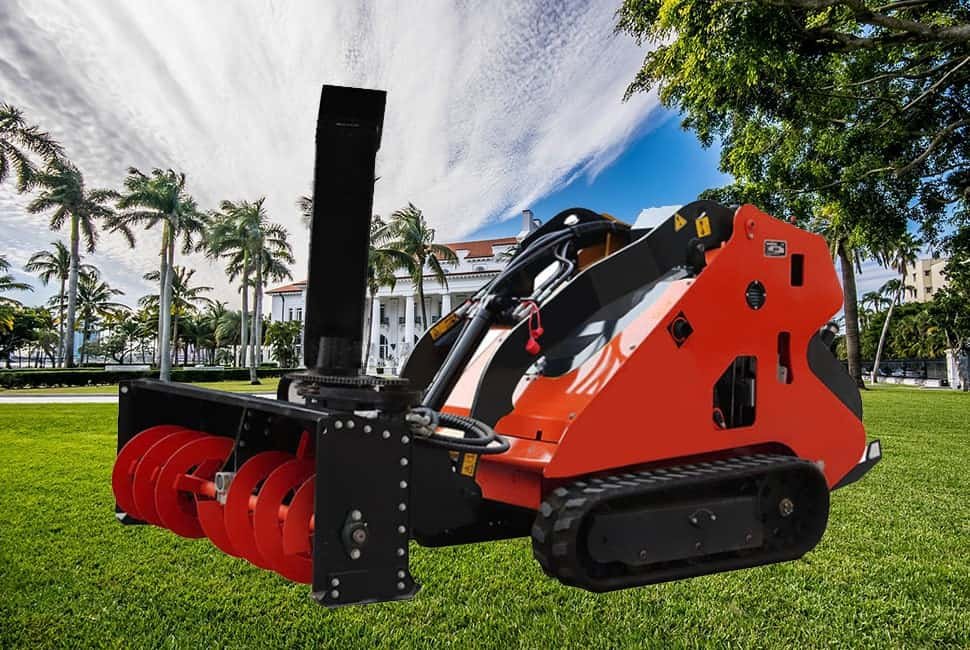Excavator attachments are essential tools that enhance the versatility of your machine. They allow you to perform specialized tasks that a standard bucket cannot handle. Understanding the most common types of attachments is key to making the most of your equipment.
Excavator attachments range from basic tools like the excavator bucket to advanced options like the hydraulic brush cutter for excavator. These attachments enable efficient work across a variety of industries, from construction to land management. Selecting the right attachment for your mini or compact excavator ensures better productivity and cost-effectiveness.
Now, let’s dive deeper into the different types of excavator attachments and their specific uses.
What are Excavator Attachments and Why are They Important?
Excavator attachments are innovative tools that can be seamlessly integrated into the excavator’s arm, enabling it to perform a variety of tasks beyond the basic digging capabilities. These attachments not only enhance the machine’s efficiency and functionality but also greatly reduce the time and labor required for various operations.
The versatility of excavator attachments is essential for expanding the range of activities that an excavator can undertake. Whether you need to dig trenches, crush debris, or lift heavy objects, there is a specific attachment designed to meet the demands of each task. Moreover, these attachments contribute to improved safety by minimizing the need for manual labor, thereby reducing the risk of accidents and injuries on the job site.
Excavator attachments are indispensable in various industries, including construction, agriculture, demolition, and forestry. For instance, a hydraulic brush cutter attachment allows workers to clear land more efficiently by effortlessly cutting through dense vegetation. Similarly, excavator forks are ideal for handling and transporting heavy materials, such as pallets or large logs, with ease.
By investing in the right attachments, you can significantly enhance the productivity of your excavator, particularly for tasks that require precision and power. This strategic investment not only increases the machine’s capabilities but also optimizes the overall workflow, leading to more efficient project completion and cost savings in the long run.
Common Types of Excavator Attachments
There are numerous attachments available for excavators, each designed for specific tasks. Here are 15 of the most common and versatile attachments.
From the basic excavator bucket to the powerful hydraulic brush cutter for excavator, the right attachment can make your excavator much more efficient on the job site. Here are some of the most popular types:
- Excavator Bucket: The standard attachment for digging and material handling. It comes in various sizes and designs to suit different tasks, from general digging to heavy-duty trenching. The excavator bucket is a must-have for construction, landscaping, and mining projects.
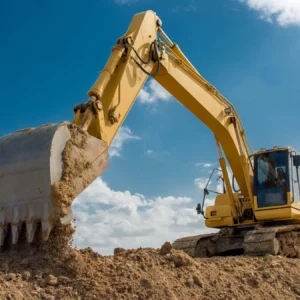
- Hydraulic Brush Cutter for Excavator: Perfect for clearing thick brush, weeds, and small trees. This attachment is often used in land reclamation, forestry, and farm management. It helps manage overgrown areas and maintain clear landscapes.

- Auger Excavator Attachment: Ideal for drilling precise holes, this attachment is commonly used in fence installation, tree planting, and pole-setting. It ensures uniform hole depth and is suitable for a wide range of soil conditions.

- Excavator Hammer Attachment: Used for breaking hard materials like rock or concrete, the hammer attachment is invaluable in demolition and mining tasks. It delivers powerful impact force to break through tough surfaces.

- Excavator Ripper Attachment: Used for ripping through tough ground, this attachment is commonly used in mining and construction when dealing with hard or compacted soil. It is designed to loosen soil, break through rock layers, or clear obstacles.
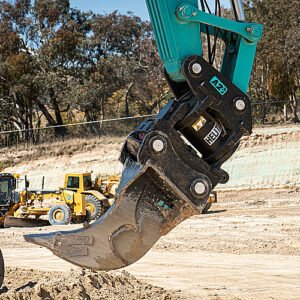
- Excavator Forks: These are excellent for lifting and transporting large materials like timber, pipes, or steel beams. Excavator forks are great for handling bulky items that need to be moved or stacked.

- Mini Excavator Rake: A lighter version of the standard rake, ideal for smaller digging jobs and land clearing in tight spaces. It’s perfect for collecting debris or preparing a site for planting or construction.
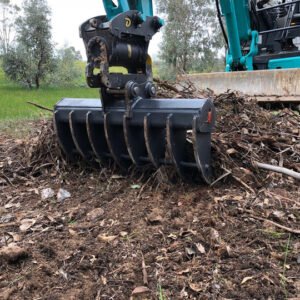
- Excavator Rotating Grapple: This versatile attachment rotates 360 degrees, making it perfect for grabbing, holding, and rotating materials in demolition, construction, or recycling tasks. Its versatility allows for efficient material handling in various directions.

- Concrete Pulverizer: A demolition tool designed to crush concrete into smaller, manageable pieces. Often used in large-scale demolition projects, the pulverizer helps break up structures and prepares materials for recycling.

- Excavator Grapple Bucket: Combining the features of a bucket and a grapple, this attachment is perfect for grabbing and transporting loose materials or debris. It offers the best of both worlds for handling different material types.

- Vibro Rip: Specially designed for high-speed vibration to break up materials, ideal for soil loosening in highway and railway projects. This attachment helps prepare the ground quickly and efficiently for other types of construction work.

- Excavator Sieve Bucket: Used for sorting and sifting materials, the sieve bucket can help separate dirt, sand, and gravel from larger rocks and debris. It’s perfect for fine-tuning material separation at construction sites.

- Compaction Wheel: Used for compacting the soil, the compaction wheel is essential for creating stable foundations for roads, buildings, and other infrastructure. It ensures uniform compression to improve ground stability.

- Excavator Magnet: A magnetic attachment used to pick up scrap metal. Commonly used in recycling and demolition projects, it helps in clearing metal debris efficiently.

- Excavator Trenchers: Excavator trenchers are designed to dig precise and narrow trenches, often used for installing pipelines, cables, or irrigation systems. The trenching attachment provides exact trench dimensions and depth.

- Быстрая сцепка: The quick hitch is an attachment that allows you to quickly change between different buckets or tools without needing to leave the cab of the excavator. It increases efficiency and minimizes downtime.

- Hydraulic Thumb: The hydraulic thumb is an attachment that works in conjunction with the bucket or grapple. It allows the operator to grab and hold materials more securely, especially when lifting irregular objects or debris.

- Tilting Bucket: The tilting bucket allows the operator to adjust the bucket’s angle to perform tasks like grading or leveling without repositioning the excavator. It’s particularly useful for roadwork and landscaping.

- Cleaning Bucket: A specialized bucket for cleaning up debris, dirt, and unwanted material from a site. It is perfect for cleaning out trenches, ditches, and general site clean-up.

How to Choose the Right Excavator Attachment for Your Project?
Choosing the right attachment for your excavator is crucial for maximizing efficiency and achieving the desired results in your project. Several factors come into play when making this decision, such as the nature of your project, the size of your excavator, and the specific tasks you need to complete.
To select the most suitable attachment, it’s important to consider the weight capacity of your excavator, the type of soil or material you’re working with, and the level of efficiency required for the task at hand. For instance, if you’re involved in a demolition project, an excavator hammer attachment or a concrete pulverizer would be ideal choices. These attachments are designed to break down and crush concrete effectively, making them perfect for such projects.
On the other hand, if you’re clearing land, a hydraulic brush cutter attachment for your excavator or an excavator rotating grapple can be highly beneficial. The hydraulic brush cutter is excellent for cutting through dense vegetation, while the rotating grapple provides better maneuverability and material handling capabilities, allowing you to efficiently remove debris and clear the land.
For precision digging tasks, a mini excavator rake or an auger excavator attachment might be the best options. The mini excavator rake is ideal for leveling and grading surfaces, while the auger attachment allows for accurate and efficient drilling of holes.
If you need to switch between tools quickly, investing in a quick hitch can significantly streamline the process. This attachment enables rapid tool changes, allowing you to switch between different attachments without wasting time. Additionally, for improved material handling, you can consider using a hydraulic thumb or a tilting bucket. The hydraulic thumb provides extra grip and control when handling materials, while the tilting bucket offers enhanced flexibility and precision in digging and loading tasks.
By carefully considering these factors and selecting the appropriate attachments, you can optimize your excavator’s performance and ensure that your project is completed efficiently and effectively.
Краткое содержание
Excavator attachments are versatile tools that significantly enhance the functionality of your machine, enabling you to perform a diverse array of tasks with ease. Gaining a comprehensive understanding of the various types of attachments and their specific applications is essential for optimizing productivity on any construction site or project.
By carefully selecting the appropriate attachment for your particular project, you can ensure that your excavator operates at peak efficiency, which not only streamlines the work process but also results in substantial time and cost savings. For instance, a digging bucket attachment is perfect for excavating soil and loading materials into trucks, while a grading blade attachment can be used to level surfaces and create smooth, even terrain.
Additionally, there are attachments designed for specialized tasks, such as a hydraulic breaker for breaking up concrete or asphalt, a grapple for handling and moving large objects, or a compactor for compacting soil and other materials. Familiarizing yourself with these attachments and their capabilities allows you to choose the best one for each task, ultimately maximizing the efficiency and effectiveness of your excavator.
In summary, excavator attachments play a vital role in expanding the capabilities of your machine and enabling you to tackle a wide range of tasks efficiently. By understanding the different types of attachments and their specific uses, you can make informed decisions that lead to increased productivity, reduced downtime, and significant cost savings for your project.

